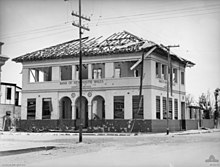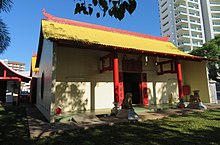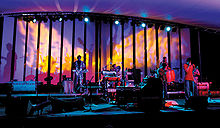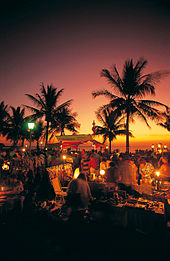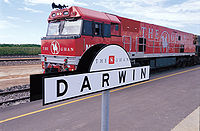Darwin (Northern Territory)
| Darwin | |||||||
|---|---|---|---|---|---|---|---|
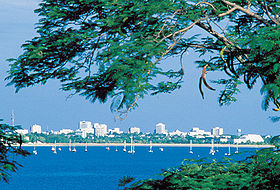
|
|||||||
|
|||||||
|
|||||||
|
|||||||
|
|||||||
|
|||||||
|
|||||||
|
|
|||||||
Darwin is the largest city and capital of the Northern Territory in Australia as well as the northernmost city in the country with approx. 118,000 inhabitants (as of 2016).
Darwin was founded in 1869 and has since been rebuilt three times after being almost completely destroyed by cyclones in 1897, 1937 and 1974 .
Darwin is known as the “Gateway to Asia” and is the host of the Arafura Games and the starting point for tours to Litchfield National Park or Kakadu National Park . There are flights to Oceania and Asia from Darwin International Airport , the city's airport.
City structure
The city of Darwin is divided into 41 districts ( suburbs ), which are combined into four electoral districts ( wards ). Some of the municipalities in the south extend beyond the city limits and also include unincorporated community ( unincorporated area ) of East Arm A, including especially the Municipality Charles Darwin (National Park) as well as Hidden Valley and Berrimah.
| District map | Chan Ward | Lyons Ward | Richardson Ward | Waters Ward |
|---|---|---|---|---|
|
|
The last two suburbs , Buffalo Creek and Holmes, were established in 2007. They are still largely undeveloped, especially Buffalo Creek.
location
The urban area of Darwin borders in the east on the community Litchfield Municipality (districts Mickett Creek and Knuckeye Lagoon with the Robertson Barracks). In the south, the three boroughs of Eaton (airport), Hidden Valley and Berrimah extend to the unincorporated area of the East Arm . In the west and north, the urban area is bounded by the coast ( Beagle Gulf ) and the natural harbor of Port Darwin .
history
On September 9, 1839, John Clements Wickham and John Lort Stokes landed on a survey voyage in Australian waters with their ship HMS Beagle in what is now Darwin's Bay and named their anchorage Port Darwin after the young Charles Darwin , who was on board the ship between 1831 and 1836 had toured the Galapagos Islands .
Frederick Henry Litchfield explored the area of what is now Darwin in 1865. On January 5, 1869, it was founded here with 135 settlers under the leadership of George Goyder Palmerston , named after the British Prime Minister Lord Palmerston , which gained popularity with its connection to the Australian telegraph network and isolated gold discoveries in the surrounding area until it was in 1911 as the capital of the Northern Territory, which was still part of South Australia until 1978, it was renamed Darwin again.
Darwin gained increasing importance in the course of the Second World War , when it was evacuated to a population of 2,000 due to a feared Japanese invasion and a crew of 32,000 Allied soldiers were stationed in Darwin. On February 19, 1942, the city was bombed by a total of 188 Japanese aircraft, which in addition to the city's fuel depots, almost completely destroyed the area around the port. The air strike on Darwin killed at least 243 civilians and soldiers. The bombardment was the first attack on Australian territory since the state was founded. Four of the six aircraft carriers and their assigned bomber squadrons were already involved in the attack on Pearl Harbor . They dropped significantly more bombs on Darwin than on Pearl Harbor, although far less military importance was attached to the attack. Eight Allied warships were sunk that day. The management of civil defense and military defense collapsed because the preparations for a possible attack had been criminally neglected. Many more air raids followed, of which those on March 28 and June 16, 1942 and May 2, 1943 were the most important.
From March to April 1946, three military tribunals met in Darwin to atone for war crimes committed against Australians as appendices to the war crimes trials in New Guinea .

On December 25, 1974, Darwin was hit directly by Cyclone Tracy . 66 residents were killed, and more than 70 percent of the buildings in the city, mostly old brick-built houses, were destroyed. After the natural disaster, around 30,000 of the then 43,000 inhabitants were brought out of the city by plane. This airlift was the largest such operation in Australian history . The city was rebuilt again using more stable building materials and techniques.
In the early 1980s, the satellite city of Palmerston emerged about 20 km south of Darwin. The Adelaide – Darwin line was completed on September 17, 2003.
On November 16, 2011, US President Barack Obama and Australian Prime Minister Julia Gillard announced to the public that an American military base with 2500 US Marines was to be established in Darwin . This is the third US base in Australia after Okinawa in Japan and Gunsan in South Korea in the Asian Pacific.
Topography and climate
Darwin has a tropical climate with a dry and rainy season. The dry season extends from May to September. During the day it is almost always sunny and dry and the humidity is around 50%. In the cool months (June / July) the lowest temperatures are on average 20 ° C and the maximum temperatures are 31 ° C. From December to April it rains very often in the late afternoon due to the monsoons , thunderstorms sweep the country and the humidity is often 95%, but the temperature can drop to 26-28 ° C for hours. Darwin is the city in Australia with the lowest "high" temperature. Every day it is 33 ° C, a cold day is 32 ° C and a hot day is 34 ° C.
| Darwin | ||||||||||||||||||||||||||||||||||||||||||||||||
|---|---|---|---|---|---|---|---|---|---|---|---|---|---|---|---|---|---|---|---|---|---|---|---|---|---|---|---|---|---|---|---|---|---|---|---|---|---|---|---|---|---|---|---|---|---|---|---|---|
| Climate diagram | ||||||||||||||||||||||||||||||||||||||||||||||||
| ||||||||||||||||||||||||||||||||||||||||||||||||
|
Average monthly temperatures and rainfall for Darwin
Source: wetterkontor.de
|
|||||||||||||||||||||||||||||||||||||||||||||||||||||||||||||||||||||||||||||||||||||||||||||||||||||||||||||||||||||||||||||||||||||||||||||||||||||||||||||||||||||||||||||||||||||||||||||||||||
Attractions
- The Museum and Art Gallery of the Northern Territory has an extensive collection of natural science specimens and an exhibition of indigenous art.
- In the over 100 years old, by the German émigré Dr. Wooden, botanical gardens are various landscaped biotopes - including a monsoon forest and a tropical rainforest - accessible to visitors.
- The never completed tunnel systems , known as WW2 Oil Storage Tunnels , which were constructed for the underground storage of fuel after the Japanese air raid in 1942, are now a museum that provides information about the events of that time.
- There are numerous art galleries in Darwin devoted exclusively to Aboriginal art.
- The Parliament House , built in 1990-94, is the seat of the parliament of the Australian Northern Territory. Not far from it is the Government House , built in 1878–79 , the oldest European building in the Northern Territory. It is the residence and official residence of the Northern Territory administrator.
- The Chinese All Deities Temple on Wood Street is one of the last remaining buildings in the city's Chinatown. It was founded in 1887 and was badly damaged by cyclones in 1897 and 1937, and by bombs in 1942 during the Japanese air raids on Darwin . It was then looted by military personnel stationed in Darwin. After the war, the temple was rebuilt, but was completely destroyed by Cyclone Tracy on December 24, 1974. The reconstruction was based on old drawings, plans and photos and was completed in 1978. The temple is now visited by followers of Buddhism , Taoism and Confucianism . The richly decorated statues of several deities stand on the main altar. In front of the temple there are stone lion figures as guardians, next to it is a chapel ( memory chapel ), in which their names can be seen on wooden plaques in memory of the deceased. When the temple was rededicated in 1978, an offshoot of the Bodhi tree (Ficus religiosa) was planted in front of it, which grew into a stately tree.
- Darwin has several modern churches. The Catholic Cathedral of St Mary's Star of the Sea Cathedral was inaugurated in 1962 after the foundation stone was laid in 1958. The Uniting Church was built in 1960. The current building of the Anglican cathedral Christ Church Cathedral was inaugurated in 1977 and still contains some components of the previous building from 1936, which was significantly damaged in the Japanese air raid on Darwin on February 19, 1942 and almost completely destroyed by cyclone Tracy in 1974.
- Because of the severe damage Darwin suffered from cyclones and from air raids during World War II, only a few buildings from the 19th century or the beginning of the 20th century remain in the city. One of the most striking is the former court building, Administrator's Office , built in 1883 , which also served as a police station. It survived World War II almost unscathed, but was destroyed by Cyclone Tracy in December 1974. It was not until 1979 that the decision was made to rebuild the ruined building. Reconstruction was completed in 1981 and the building has been a listed building since 1996. Opposite is the Survivors Lookout , which offers an impressive view of the newly redesigned port area and the marina.
- The ruins of the Town Hall , originally built in 1883 and destroyed by the cyclone in 1974, can be seen in a green area in the south of the city center . Opposite is Browns Mart , a stone building built in 1880 that originally served as a stock exchange for mining companies and was later converted into a theater.
Culture and society
Darwin is known as the "Gateway to Asia" and is a particularly multicultural city. A total of around 75 nationalities live in Darwin, and around a quarter of the residents are Aboriginal or Torres Strait Islanders .
Darwin developed from a rather harsh outpost into a lively tropical city. Weekly markets such as Mindil Beach Sunset (Thursday and Sunday in the dry season), Parap, Nightcliff and Rapid Creek markets are now an integral part of the lifestyle that one enjoys in Darwin.
Holidays and celebrations
The Territoryians celebrate their Territory Day on July 1st . This is one of two days of the year that fireworks are allowed (the other is the Chinese New Year celebrations ). The main festivities take place on Mindil Beach, where government sponsored fireworks are popular every year.
The Darwin Festival , also annual, includes comedy, dance and theater performances, musical performances, film screenings and the NT Indigenous Music Award . Other festivals in Darwin include Glenti , a festival for the large Greek community of Darwin, and India @ Mindil , a similar festival for the smaller Indian community. The Chinese New Year is also celebrated in Darwin and is a highlight of the Asian festivities in Darwin.
A rather unusual event is the Darwin beer-can regatta , which takes place every year in Darwin. The city of Darwin, which has long held the world record in beer per capita consumption, celebrates its love for beer here . The boats for this regatta may only consist of beer cans. Other major events in August include the Darwin Cup Horse Race , the Rodeo and the Super V8 car race in Hidden Valley.
Museums
The Museum of the Northern Territory in Darwin provides an overview of the history of the region, including an exhibition on Tropical Storm Tracy , which destroyed almost all of Darwin at Christmas 1974, and a collection of boats from the Pacific Islands.
Music and art
Darwin has a vibrant arts scene: the Darwin Festival , Darwin Fringe Festival and the Bass-in-the-Grass concert take place annually. There are also a number of indoor and outdoor concerts. The Aboriginal galleries in the city center also contribute to the cultural scene.
Literature and film
In the 1960s, Darwin was described in the book "Maestro" by Peter Goldsworthy as follows: "That small, tropical hothouse of a port, half outback, half oriental, lying at the tip of northern Australia".
“Sit Down Up North”, written by Northern Territory Administrator Ted Egan, depicts Darwin in the 1950s.
The 2008 film Australia by Baz Luhrmann with Nicole Kidman stars in Darwin and the surrounding area . The second half of the three-hour epic takes place in the city at the time of the siege in World War II. Due to the lack of historical building fabric, the scenes were not shot in Darwin, but in Bowen and in the studio.
leisure
The city of Darwin has extensive and often deserted beaches. These include Casuarina Beach and the famous Mindil Beach, which is home to the Mindil Beach market in the dry season.
Casuarina Beach has been an official nudist beach since 1976. While swimming in the sea should exercise caution until May, especially in the period from October, since a highly poisonous jellyfish , the sea wasp (ger .: "Box Jellyfish") occurs.
Crocodiles are a threat to bathers all year round. Saltwater crocodiles are widespread around Darwin, but are sometimes seen in the harbor and near local beaches. Every year more than 200 crocodiles are caught in the port and released into the surrounding rivers.
Fishing is a very popular activity for the locals, but visitors from all over the world also try their hand at barramundi fishing in Darwin . The barramundi is a well-known and popular food fish in the region . Mary River , Daly River , South, and East Alligator Rivers are just a few of the waters near Darwin for barramundi fishing. The main catches off the coast of Darwin are giant dark groupers , the mackerel species Scomberoides commersonnianus (locally called queenfish ) and snapper .
entertainment
The lively night scene of Darwin is concentrated on the main downtown street, Mitchell Street, with a wide range of restaurants, a few theaters, a casino and cinemas, including an open-air cinema. This cinema is only open in the dry season (April to October) and mainly shows “Independent” and “Arthouse” films.
In the dry season there is a weekly market, such as the Mindil Beach Market, the Nightcliff Market, the Parap Market or the Rapid Creek Market, almost every day.
Sports
Every two years since 1991 (with the exception of the 2003 SARS outbreak ), Darwin has hosted the Arafura Games , a major regional sporting event. Darwin's first test match in cricket took place at Marrara Cricket Ground in July 2003 , followed by a second test match in July 2004. Australian-rules football and rugby league are played year-round.
Melbourne's Western Bulldogs ( Australian Football League ) play many matches each year on the Marrara Oval. The Aboriginal All-Stars also take part in the preseason games. In 2003, 17,500 people set a record for attending a pre-season game in Darwin. It was an All-Stars and Carlton Football Club game at the Marrara Oval.
The "V8 Supercars" event draws thousands of motorsport fans to the Hidden Valley Complex every year .
Another major sporting event is the Darwin Cup, which traditionally takes place on the first Monday in August at Fannie Bay Racecourse and attracts so many people that Sky Racing began broadcasting the event in 2003. Darwin Cup Day is a public holiday in the Northern Territory (Picnic Day public holiday).
transport
railroad
The Northern Australian Railway operated from 1887 to 1976, the expansion of which lasted in several sections from Darwin to Larrimah . The new Central Australian Railroad from Alice Springs to Darwin was completed on September 17, 2003 and now connects Darwin with Adelaide and other Australian cities. It is mainly used for freight traffic. With the passenger train " The Ghan " from Adelaide via Alice Springs and Katherine , travelers can reach the station, which is 25 km outside the city in an industrial area of Darwin, twice a week.
air traffic
The Darwin Airport offers flights to Singapore and Ho Chi Minh City ( Jetstar Airways ), Bali (Jetstar Airways), Kuala Lumpur , Manila and East Timor ( Airnorth ) to.
Qantas , Australia's largest airline, flies from Darwin to Alice Springs, Gove Airport, Cairns , Brisbane , Sydney , Melbourne , Canberra , Adelaide and Perth . Virgin Australia flies to Brisbane and Melbourne, Skywest and Airnorth fly to Broome .
Streets
Darwin can be reached via the Stuart Highway , which runs the entire length of the Northern Territory from Darwin in a southerly direction via Katherine, Tennant Creek and Alice Springs to Adelaide.
The city also has an extensive network of cycle paths, most of which run along the beach.
Ferries
There are mainly tourist ferry connections to various islands, for example the Arafura Pearl connects the Tiwi Islands and Darwin (Cullen Bay).
tourism
Tourism is one of the largest industries in Darwin, employing 8,391 direct workers (June 2006 figures).
Most tourists visit Darwin in the dry season from April to September.
About 1.38 million people visited the Northern Territory in 2005/06. They spent a total of 9.2 million nights there, spending over 1.5 billion Australian dollars.
Darwin is the starting point for trips to Kakadu National Park , Litchfield National Park and Katherine Gorge in Nitmiluk National Park . Although the seasons are generally divided into the dry and rainy seasons, traditionally there are six seasons. The naming of these seasons depends on the respective Aboriginal community. The Bininj calendar is valid for example in the Kakadu National Park.
According to the operator, a popular tourist attraction is the commercially operated feeding of hundreds of fish at Doctor's Gully in the city center: At high tide, fish coming in from Darwin harbor are hand-fed.
Feeding the crocodiles from small ships on the Adelaide River is also worth seeing . There, pieces of meat are held over the water on a long pole. The crocodiles jump out of the water for the pieces of meat.
History of aviation
Darwin played a role for many aviation pioneers in Australia. On December 10, 1919, Captain Ross Smith landed with his brother Keith Smith and two other men in Darwin, winning a £ 10,000 prize from the Australian Government for the first flight from London to Australia in under 30 days. Smith and his crew flew in a Vickers Vimy and landed on the airfield now known as Ross Smith Avenue. Other aviation pioneers were Amy Johnson , Amelia Earhart , Sir Charles Kingsford Smith, and Bert Hinkler .
Darwin hosted Australian and American pilots during World War II. Makeshift airfields were built in and around Darwin, which are still visible today and some of them are still in use. Nowadays, military aerial exercises are held several times a year in Darwin.
In 1934 Darwin was a stopover in the "Centenary Air Race" from London to Melbourne; the official name of this competition was " MacRobertson Air Race ". It was won by Tom Campbell Black and C. W. A. Scott in a De Havilland DH.88 Comet .
military
Around 4500 Australian soldiers and the headquarters of the 1st Brigade and 1st Aviation Regiment are stationed in the Robertson Barracks around 22 km southeast of Darwin . On November 16, 2011, Australia and the USA agreed the stationing of 200 to 250 US Marines from 2012. By 2017, a further 2250 US soldiers are to be stationed. Around 320 km southeast of Darwin, the USA is already using RAAF Base Tindal for flights by long-range B-52 bombers .
Town twinning
Partnerships
-
 Kalymnos , Greece since April 23, 1982
Kalymnos , Greece since April 23, 1982 -
 Anchorage , USA ( Alaska ) since July 28, 1982
Anchorage , USA ( Alaska ) since July 28, 1982 -
 Ambon , Indonesia since October 28, 1988
Ambon , Indonesia since October 28, 1988 -
 Haikou , People's Republic of China since September 5, 1990
Haikou , People's Republic of China since September 5, 1990 -
 Milikapiti , Australia (Northern Territory) since July 5, 1999
Milikapiti , Australia (Northern Territory) since July 5, 1999 -
 Dili , East Timor since September 18, 2003
Dili , East Timor since September 18, 2003
Friendships
sons and daughters of the town
- Andrew N. Liveris (born 1954), manager
- Frank Farina (* 1964), soccer coach and former soccer player
- Nova Peris (* 1971), former hockey player, sprinter and current politician
- Graeme Brown (* 1979), racing cyclist
- Nicole Castro (* 1984), Australian-French basketball player
- Chris Spring (* 1984), Australian-Canadian bobsleigh athlete
- Danni Miatke (* 1987), swimmer
- Jessica Mauboy (* 1989), singer
- Jesse Pinto (* 1990), Australian-East Timorese soccer player
Web links
- Tourism information
- Darwin City Council (English)
- Description of the city, the surrounding area and its sights , australien-info.de
- Palmerston Town Council (English)
- Darwin at the Australian Bureau of Statistics (2001 Census). (English)
- Waterfront Darwin (English)
- Future projects in Darwin (English)
- Overland Telegraph (web archive) ( Memento from March 22, 2010 in the Internet Archive ) (English)
Individual evidence
- ↑ a b Australian Bureau of Statistics : Darwin ( English ) In: 2016 Census QuickStats . June 27, 2017. Retrieved April 5, 2020.
- ^ A b c History of Darwin ( English ) Darwin City Council. Retrieved August 31, 2012.
- ↑ Philip Piccigallo: The Japanese on Trial. Austin 1979; ISBN 0-292-78033-8 (Chapter 7 "Australia and Others")
- ^ Abdul Khalik: New US base in RI's backyard. In: The Jakarta Post . November 17, 2011, accessed November 23, 2011 .
- ↑ Robert P.Hertwig: Australia , S. 50. Munich 1985
- ↑ http://www.gcatholic.org/churches/oceania/2326.htm
- ↑ http://www.iubilaeummisericordiae.va/content/gdm/es/mondo/porte-della-misericordia.event.st--mary-s-star-of-the-sea-cathedral-catholic-diocese-of- darwin-.html
- ↑ http://dmuc.unitingchurch.org.au/about-us/
- ↑ https://christchurchcathedral.org.au/about/history/
- ↑ Information board on the building, accessible from the Commons .
- ^ Veronika Pavel: Australien - Osten und Zentrum , p. 293. Markgröningen 2011
- ↑ Aquascene
- ↑ Jumping Crocodiles



